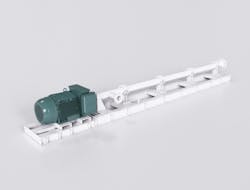Editor's Note:
"How They Made it Work" is a column that features some of the latest technological advancements in the chemical process industry. Here, Chemical Processing asks experts from various technology providers to provide insight into their innovations and how they're helping chemical manufacturers operate their plants more efficiently and effectively.
In our first installment of “How They Made it Work,” Robert Boyce, local division manager for IEC-LV Motor at ABB’s U.S. operations, provides insight into the potential benefits of combining high-power, low-voltage motors with variable frequency drives in chemical operations.
Company:
ABB
Technology:
ABB’s ECP5000 series offers an alternative to medium-voltage (MV) equipment. Electric motor manufacturers have extended their drive for energy efficiency from general-purpose motors to severe-duty motors. In combination with a variable frequency drive (VFD), this type of motor can increase energy efficiency and achieve IE5 efficiencies, the highest level currently recognized according to IEC TS 60034-30-2.
Significance in chemical operations:
In traditional chemical operations, motors and other equipment are under attack every day. As a result, the severe-duty feature-set has been the standard due to the uniquely harsh environments found in these operations. Motors need to be protected in dusty and/or wet environments. They also require a paint/coating that can withstand the corrosive nature inherent to chemical processing operations.
ECP motors have historically been designed for these applications. The ECP5000 line is IP66 rated to provide a higher level of protection against the ingress of contaminants. This can contribute to a longer bearing and motor life. Additionally, a C4-M paint system was added to provide extra durability in harsh/corrosive environments further extending the lifetime of the motor.
Challenges addressed:
The shift from diesel engines to electric motors in pumping applications poses challenges that extend beyond a simple one-to-one replacement. Infrastructure development, including extending electricity to new areas, becomes crucial. Configuring the motor-to-pump relationship is not always straightforward, requiring careful consideration of coupling sizes and torque-curve matching. Electric pumps demand suitable controls, particularly for flow regulation through motor speed adjustment, often necessitating motors compatible with variable frequency drives (VFDs).
While electrification may raise upfront capital costs, including VFD investment and power supply extension, long-term savings in electricity bills offset these expenses. Additionally, electrification reduces greenhouse gas emissions and diesel particulates. Overcoming the challenge of changing established practices, such as education and training for operators accustomed to diesel engines, is essential. Electric motor maintenance differs but is generally less demanding. Regular inspection and preventive measures, like correct connection tightening and lubrication, ensure motor longevity. Manufacturers aid operators by incorporating sensors and thermal protections. When properly maintained, electric motors can last for decades, aligning with the growing emphasis on energy efficiency and sustainability.
Unique features:
Electric motors, equipped with VFDs, enhance speed control, adapting dynamically to application demands, thereby offering potential energy savings. Unlike constant full-speed operation, which accelerates wear and tear, VFDs may enhance the longevity of a motor by allowing them to operate at optimal speeds, as needed.
Beyond energy savings, VFDs facilitate smoother acceleration, deceleration, and reduce stress on motor components. This aligns with global sustainability goals, emphasizing energy efficiency to minimize environmental impact. While not all pumping applications mandate VFDs, their use becomes pertinent when dynamic speed adjustments are essential.


